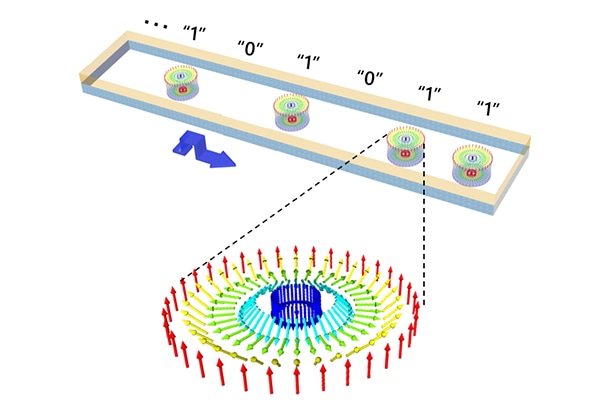Nov 20 2019
For the first time, a team of researchers at Tohoku University has been successful in demonstrating the formation and current-triggered motion of synthetic antiferromagnetic magnetic skyrmions. It is anticipated that the proven findings will open new avenues toward new functional information processing and storage technologies.
 Schematic of magnetic skyrmion and magnetic devices utilizing skyrmion. Image Credit: © Takaaki Dohi and Shunsuke Fukami.
Schematic of magnetic skyrmion and magnetic devices utilizing skyrmion. Image Credit: © Takaaki Dohi and Shunsuke Fukami.
A magnetic skyrmion is said to be a topological object, which develops in magnetic systems. It has the ability to form at the nanoscale and to be triggered by a current, exhibiting potential for different applications where information is signified by the number, presence, absence, or state of the skyrmion. But there remains one obstacle—the skyrmion Hall effect.
The skyrmion Hall effect blocks the skyrmion from moving along the current; rather, the skyrmion moves in a direction diagonal to the current due to the intrinsic angular momentum of the skyrmion. This leads to the degradation of the stability and efficiency of devices. The demand for technology that conquers the skyrmion Hall effect is high.
The research team, including Professor Hideo Ohno (current Tohoku University President), Associate Professor Shunsuke Fukami, and PhD candidate Mr Takaaki Dohi, created a magnetic stack structure wherein the skyrmion moves along the current, evading the skyrmion Hall effect.
The created structure successfully leverages three spintronics effects, Dzyaloshinskii-Moriya (DM) interaction, Ruderman-Kittel-Kasuya-Yosida (RKKY) interaction, and spin-orbit (SO) interaction. Thanks to the RKKY and DM interactions, a synthetic antiferromagnetically coupled (SyAF) skyrmion is successfully formed.
Furthermore, due to the SO interaction, the SyAF skyrmion is moved with a considerably smaller current than traditional single ferromagnetic skyrmion. Also, suppression of the skyrmion Hall effect has been validated for the SyAF system.
This is the first demonstration of the creation and current-triggered motion of magnetic skyrmion evading the skyrmion Hall effect at room temperature. Eventually, the current finding is expected to open new avenues to innovative spintronics devices wherein topology arising in magnetic materials is completely leveraged.